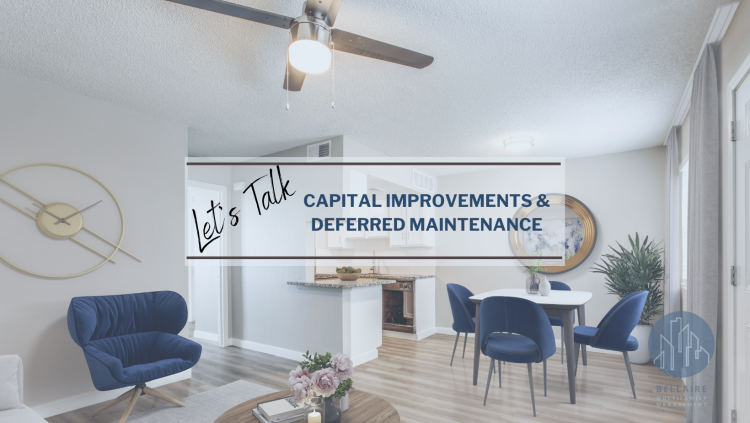Managing a multifamily property comes with a plethora of responsibilities, and one key aspect is budgeting for capital improvement projects and addressing deferred maintenance. Capital improvement projects are investments made to enhance the value of a property, while deferred maintenance refers to postponing necessary repairs or replacements. Both are critical elements of property management that, when overlooked or neglected, can lead to larger issues in the future, resulting in higher costs and decreased property value.
Prevention is Better than The Cure
Budgeting for capital improvement projects is essential for the long-term success of multifamily property management. Capital improvement projects can include renovations, upgrades, replacements, and additions that improve the functionality, aesthetics, and overall value of a property. Examples of capital improvement projects in multifamily properties may include upgrading common areas, improving landscaping, replacing outdated systems (such as HVAC or plumbing), or enhancing amenities like fitness centers or community spaces. Budgeting for these projects allows property managers to plan and allocate funds in advance, ensuring that the necessary improvements are made in a timely manner.
One key benefit of budgeting for capital improvement projects is that it helps prevent costly emergency repairs in the future. By proactively identifying and addressing potential issues through capital improvement projects, property managers can avoid unexpected breakdowns or failures that could result in emergency repairs, higher costs, and disruptions to residents. For example, replacing an aging roof or upgrading electrical systems before they fail can prevent water leaks or electrical outages that could damage units and common areas, leading to costly repairs and resident dissatisfaction.
Preserving Asset Value
Budgeting for deferred maintenance is equally crucial in multifamily property management. Deferred maintenance refers to delaying necessary repairs or replacements due to budget constraints or other reasons. While it may save money in the short term, neglecting deferred maintenance can lead to more significant issues in the long run. For instance, ignoring a leaking faucet or delaying repairs to a deteriorating parking lot can result in more extensive damage, higher repair costs, and decreased tenant satisfaction. Deferred maintenance can also negatively impact the property’s overall aesthetic appeal and marketability, leading to lower rental rates and decreased occupancy rates.
Addressing deferred maintenance in a timely manner is vital to ensure the property’s safety, functionality, and value. Property managers should conduct regular inspections and maintenance assessments to identify deferred maintenance items and prioritize them based on urgency and severity. By budgeting for deferred maintenance, property managers can allocate funds to address these issues promptly and prevent them from becoming larger and more costly problems in the future. Regular maintenance, such as servicing HVAC systems, repairing leaks, maintaining common areas, and addressing safety concerns, should be included in the property’s annual budget to ensure proper upkeep and minimize potential risks.
In addition to avoiding costly repairs and emergency situations, budgeting for capital improvement projects and addressing deferred maintenance also helps preserve and enhance the property’s value. Well-maintained properties with modern amenities and functional systems are more attractive to prospective tenants, resulting in higher rental rates, increased occupancy rates, and better retention of existing tenants. A property that is well-maintained and updated through capital improvement projects is also likely to have a higher resale value if the owner decides to sell the property in the future.
Enhancing Tenant Satisfaction
Tenant satisfaction is a key factor in the success of multifamily property management. Happy tenants are more likely to renew their leases and recommend the property to others, which can result in reduced vacancy rates and increased revenue. Capital improvement projects that improve the quality of living for tenants, such as upgrading common areas, installing energy-efficient appliances, or enhancing security measures, can greatly enhance tenant satisfaction. Similarly, addressing deferred maintenance promptly, such as fixing broken fixtures, repairing HVAC systems, or resolving pest issues, can ensure that tenants have a comfortable and enjoyable living experience. By budgeting for and prioritizing capital improvement projects and deferred maintenance, property managers can maintain high tenant satisfaction levels and build a positive reputation in the market.
Overall, budgeting for capital improvement projects and addressing deferred maintenance is of paramount importance in your property’s performance. Proactively planning and allocating funds for capital improvement projects and timely addressing deferred maintenance can help prevent costly emergency repairs, enhance tenant satisfaction, maintain property value, and ensure the long-term success of the property. Property managers should conduct regular inspections, prioritize repairs, and include them in the annual budget to ensure that the property remains in optimal condition, minimizes risks, and attracts and retains tenants. Investing in proper budgeting for capital improvement projects and addressing deferred maintenance is a wise and strategic decision…Just Do It!

